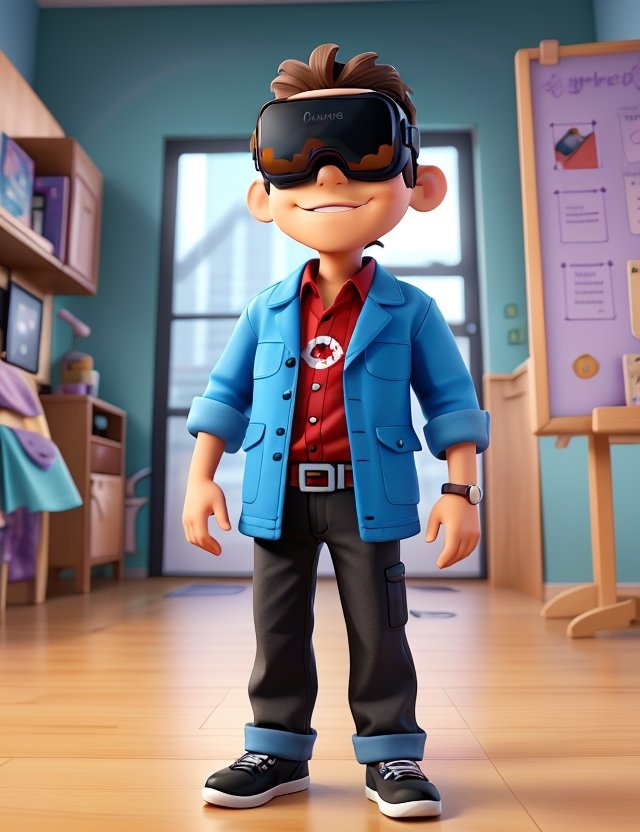The incessant advancement of technological innovation promises to further revolutionize our daily life with the future augmented and virtual reality. These technologies, which until recently sounded like science fiction, are now part of a constantly changing and expanding scenario. In this article, we will dive into the latest perspectives and developments, and how they can reshape the way we interact with both the virtual world and the real.

Contents:
Main Considerations
- Anticipation of transformations in various sectors generated by the advancement of augmented and virtual reality technologies.
- Impact of augmented and virtual reality on technological innovation and the development of new practical applications.
- Relevance of immersive experiences as part of the current daily life and in the near future.
- Research of emerging trends and the growth potential of this technological segment.
- Discussion on how augmented and virtual reality can reshape human interaction with machines and digital environments.
What is Augmented and Virtual Reality?
By entering the universe of technological innovations, two concepts gain emphasis on their ability to transform our perception of the world: augmented reality and virtual reality. These technologies are not only elements of science fiction; they are contemporary tools that are redefining human interactions with machines and digital environments.
Definition of Augmented and Virtual Reality
To clarify, augmented reality refers to the overlap of digital information, such as images or data, to the real world through devices such as smartphones or special glasses. It is a layer of virtuality that complements, but does not replace, the palpable reality. Already virtual reality creates a total immersion, transporting the user to a completely simulated environment, where all that is perceived has no correlation with real physical space.
How Do Augmented and Virtual Reality Integrate?
A integration of augmented and virtual reality results in the development of hybrid experiences that capture the benefits of both technologies. This convergence allows you to create environments that merge real and virtual elements, offering a new level of interaction and immersion. The integration of these technologies has the potential to profoundly change everyday activities, modes of production and even the management of urban spaces. It is the fusion of digital with tangible, opening a window for endless possibilities of innovation.
Understanding How Augmented and Virtual Reality Works
A augmented and virtual reality mechanics is fascinating because it combines elements of our physical world with the innovation of digital universes, allowing the creation of truly immersive experiences. By exploring immersive technology, we come across a number of devices and algorithms that work together to make this possible. Understand the key components of this process better:
- Sensors: essential to capture movements and position objects in the three-dimensional space, transform user interaction with the virtual environment into something more natural and intuitive.
- Cameras: fundamental in augmented reality, as they allow the software to identify real-world spaces and objects, so that digital images are overlaid correctly.
- Image Processing Algorithms: vital to understand and interpret the data captured by sensors and cameras, these algorithms are the core of the harmonious functioning between reality and virtuality.
- Display devices: VR glasses, smartphones and other specific devices are the windows we interact with immersive content, they need to have technology capable of supporting high-quality graphics and quick response to user commands.
Development in these hardware and software fields has been driven by an increasingly thirsty market by technological innovations that elevate user experience to a new level of immersion and interactivity.
Innovative Examples of Augmented and Virtual Reality in Day to Day
The adoption of augmented and virtual reality in practice is transforming several aspects of our daily life. Next, we'll explore examples of augmented and virtual reality in different segments, illustrating its impact and its revolutionary potential.
Augmented and Virtual Reality in Education
In education, the augmented and virtual reality offers a rich environment in interactive possibilities. Students can explore human anatomy in 3D, take virtual trips to historical sites or simulate complex scientific experiments, all in a classroom.
Impact of Augmented and Virtual Reality on Retail
In the retail sector, these technologies allow consumers to experience products without leaving the house. From virtual tasters to interior decoration simulations, the augmented reality tools provide an innovative and personalized buying experience.
Immersive Entertainment with Augmented and Virtual Reality
Entertainment was one of the first sectors to embrace augmented and virtual reality, offering immersive experiences in games and events. Examples include games that transform real space into playful scenarios and the use of VR glasses to watch shows and shows as if they were present on site.
The Advantages of Augmented and Virtual Reality
A integration of augmented and virtual reality in different spheres is already a reality, and the benefits of augmented and virtual reality are tangible and diverse. These innovative technologies offer a number of advantages that can be applied in sectors as varied as education, health, entertainment and industry.
Optimization of User Experiences
One of the main impacts of augmented and virtual reality is in optimizing the user experience. The possibility of complete immersion and intuitive interaction amplifies user engagement and satisfaction. Whether for an immersive game or for an educational application that allows students to explore the universe or dissect an organism virtually, applications are numerous and fascinating.
- Revitalizing traditional digital content, making it more attractive and memorable.
- Facilitating understanding of complex concepts through real-time simulations.
- Ability to customize interactions based on user preferences and behaviors.
Operational Efficiency and Training
In the operational context, effectiveness of augmented and virtual reality is in your ability to transform training processes and develop skills without the risks associated with training in real environments. This is particularly beneficial in sectors where failures can have serious consequences, such as aviation or medicine.
- Cost reduction with practical training, decreasing the need for material resources.
- Improved information retention through practice in a virtual controlled environment.
- Facilitation of maintenance of complex equipment, where augmented reality can override crucial information about real-world objects.
Exploration of these advanced features is only the surface of the potential that augmented and virtual reality possess. As technology develops, more doors open, and more industries begin to visualize a future where reality is just the starting point for extraordinary experiences.
Augmented and Virtual Reality in the Labour Market
O impact on the labour market provoked by augmented and virtual reality is undeniable. These emerging technologies are not only creating new professions but also redefining the skills needed for existing ones. Professionals from various sectors are facing the need to adapt their knowledge to incorporate these innovative tools into their work routines.
In a scenario where employability in augmented and virtual reality is in frank rise, companies of the most varied branches are seeking talents that can perform functions that did not exist before. Let's see some specific areas where these changes are being more felt:
- Software developers specializing in creating augmented and virtual reality applications;
- Graphic design professionals with skills in 3D modeling and animation;
- UX/UI specialists to design more immersive user experiences;
- Education and training professionals who use augmented and virtual reality to create improved learning and training programs.
Companies, in turn, are investing in training and development programs so their employees can familiarize themselves with new technological tools. The path to a more dynamic and future-prepared market involves continuous education and the enhancement of advanced digital skills.
The augmented and virtual reality provides a fertile ground for innovation, and the possibilities of practical applications seem unlimited. As the market absorbs these changes, the professional trained in these areas becomes increasingly essential for the growth and competitiveness of companies.
Augmented and Virtual Reality Technology in Industry
A industrial application of augmented and virtual reality has been transforming several industries, with a remarkable impact on the efficiency and safety of manufacturing processes. These innovative technologies allow the visualization of information and technical details in real time, directly on the equipment itself or part in manufacturing, raising the level of accuracy of the activities carried out.
In terms of innovation in manufacturing, the use of augmented reality for step-by-step assembly instructions is a clear example of how technology can minimize errors and accelerate the training of new workers. This not only reduces machine downtime, but also improves the overall quality of the final product. On the other hand, virtual reality offers detailed simulations of working environments that are crucial for virtual testing of workflows and plant layout without risking production shutdown.
- Reality Assisted Maintenance Increased: Technicians use glasses or portable devices to receive interactive visual orientations during complex repairs, reducing machine downtime.
- Immersive Training: New operators can train in safe virtual environments, without accident risks, familiarizing themselves with equipment and procedures before acting on the front line.
- Project Optimization with Prototyping Virtual: Designists and engineers use models Virtual 3D to review designs, perform adjustments and validate concepts long before physical production, saving time and material resources.
Thus, we observe that the augmented and virtual reality is not only the boundaries of an alternative reality, they are defining the vanguard of industrial productivity and the advancement in the manufacture of goods in a smarter, more agile and personalized way.
Applications of Augmented and Virtual Reality in Health
Significant advances have been achieved through improvements in health with augmented and virtual reality. Those Medical innovations not only extend the possibilities of professional treatment and training, but also offer revolutionary methods for the recovery and well-being of patients. Next, we explore two central areas benefited by such technologies.
Surgical Simulation and Medical Training
Health professionals are experiencing a leap in the quality of surgical training thanks to virtual reality. With highly detailed simulations, complex procedures can be reproduced, allowing doctors and medical students to practice surgical techniques in a controlled and risk-free environment for patients.
- Preparation for real surgeries with lower error index
- Repeat procedures to improve skills
- 3D visualization of human anatomy for deeper understanding
Support in the Treatment of Phobias and Rehabilitation
The augmented reality and the virtual open new paths to the treatment of phobias and physical rehabilitation. By creating controlled and progressive scenarios, patients can be gradually exposed to the object of their phobias or practice rehabilitation movements, significantly improving the success rates and quality of life of those involved.
- Virtual and safe exposure to physical situations
- Augmented reality games to stimulate movements in physiotherapy
- Accurate monitoring of rehabilitation progress
The Trends of Augmented and Virtual Reality for the Future
As we explore forecasts for future of augmented and virtual reality, we identify a constantly evolving technological scenario. The augmented and virtual reality, key elements in this progress, are in franc growth, driving a profound transformation into multiple spheres of everyday and professional life.
Expanding Augmented and Virtual Reality in the Game Sector
The gaming industry is one of the main beneficiaries of the expansion of these technologies. We observe an increase in player interactivity and engagement, provided by immersive experiences that define new gameplay patterns. The merger between real and digital world promotes a richer and more engaging narrative, opening doors to innovations in game development.
Integration with Other Technologies Emergings
The augmented and virtual reality does not walk isolated; its integration with emerging technologies such as artificial intelligence (IA) and the Internet of Things (IoT), is stimulating the creation of increasingly intelligent and connected solutions. IA enhances the customization and reactivity of virtual environments, while IoT enables greater interaction between devices and platform, expanding the application spectrum of augmented and virtual reality.
- Improved machine learning to create more realistic and adaptive virtual environments
- Growing use of wearables that monitor physical interaction within virtual environments
- Development of neural interfaces for device control and interaction with virtual content
We conclude that while we look at them forecasts for future of augmented and virtual reality, it is impossible to ignore the transforming potential of these technologies. A augmented and virtual growth reality promises to revolutionize not only entertainment, but also industry, education, health and beyond.
Augmented and Virtual Reality: Difference and Convergence
In advancing towards greater technological integration, it is essential to recognize the particularities that distinguish the augmented reality of virtual reality. Both play revolutionary roles in their respective spheres, although they operate under different assumptions. While the augmented reality inserts digital elements into the physical world, enriching our perception of the real, the virtual reality transports us to a completely artificial universe, redefining our sensory experience. This delicate contrast is the starting point for us to understand the growing synergy between these two technologies.
Key Differences Between Augmented Reality and Virtual Reality
To enlighten differences between augmented and virtual reality, we consider practical examples: an augmented reality user could view overlapping mounting instructions on the repairing equipment, while another, immersed in a virtual reality, would be engaged in a detailed simulation of aircraft piloting. Although both experiences are immersive, the augmented reality operates as an additional layer to our environment, while the virtual creates a new environment around the user.
Convergence perspectives Technological
We see, however, an interesting movement towards convergence of technologies of augmented and virtual reality. This trend points to a future where hybrid experiences will be common, merging the best of both worlds and creating previously unimaginable possibilities. The barriers between real and virtual become increasingly thin, and with this fusion, new paradigms in interactivity and applicability arise on the horizon, promising to fully transform not only the field of entertainment, but also education, health and industry.
FAQ
What are Augmented Reality and Virtual Reality?
Augmented Reality (RA) is a technology that overprints digital information such as images and data in the real world through devices such as smartphones and special glasses. Virtual Reality (RV), on the other hand, is an immersive experience where the user is placed in a completely virtual environment, usually using a helmet or virtual reality glasses.
What are the fundamental differences between Augmented Reality and Virtual Reality?
The main difference is that Augmented Reality integrates virtual elements into the real environment, enriching the user's current perception, while Virtual Reality creates a whole new experience replacing the physical environment with a fully digitized and controlled space.
How can Augmented and Virtual Reality benefit the educational sector?
In education, RA and VR enable the creation of more interactive and engaging learning experiences, helping to visualize complex concepts, practical training and simulation of real risk-free environments, which can strengthen information retention and motivate students.
What is the impact of Augmented and Virtual Reality in retail?
In retail, these technologies transform the way consumers interact with the products. The Augmented Reality allows, for example, customers to view how a product would be in their home before purchase, while Virtual Reality can create immersive purchase experiences, such as a virtual tour through a store.
What are some examples of use of Augmented and Virtual Reality in entertainment?
In entertainment, we find games that use RA to bring characters and challenges to the real world, while VR allows users to enter fictional worlds and interact with them in a deep way. In addition, there are experiences such as shows and sporting events that can be watched in virtual reality environment to increase immersion.
How can Augmented and Virtual Reality increase operational efficiency?
Technologies can facilitate and improve the execution of complex tasks by providing real-time instruction and essential information for workers. This is particularly useful in fields such as maintenance and manufacturing, where RA can show data and graphics superimposed on equipment, guiding the operator during the process.
How are Augmented and Virtual Reality influencing the labor market?
These technologies are creating new employment opportunities and requiring expertise in product programming, design and development. Companies are looking for professionals who can create and implement solutions in RA and RV to improve the effectiveness of operations and customer engagement.
How are Augmented and Virtual Reality applied in the industry?
In the industry, RA and RV are used to optimize design and production processes. They facilitate the visualization of prototypes, employee training and equipment maintenance through interactive manuals and detailed simulations, helping to prevent errors and increase security.
What are the possible applications of Augmented and Virtual Reality in health?
In health, these technologies offer simulations for medical and surgical training, allow three-dimensional views of body parts for more accurate diagnoses and are used in phobia treatment therapies, anxiety and physical rehabilitation.
What are the future trends for Augmented and Virtual Reality technologies?
Trends include considerable expansion in the gaming industry, where these technologies offer increasingly realistic and engaging experiences. In addition, integration with artificial intelligence and the Internet of Things is creating opportunities for smarter and more connected applications in various sectors.
How are the convergence perspectives between Augmented Reality and Virtual Reality?
Despite its differences, we observe a growing convergence between RA and VR, resulting in hybrid experiences where elements of the two technologies are combined to create new types of interaction and immersion, increasing the range of applications and the depth of digital experiences.








2 Reviews